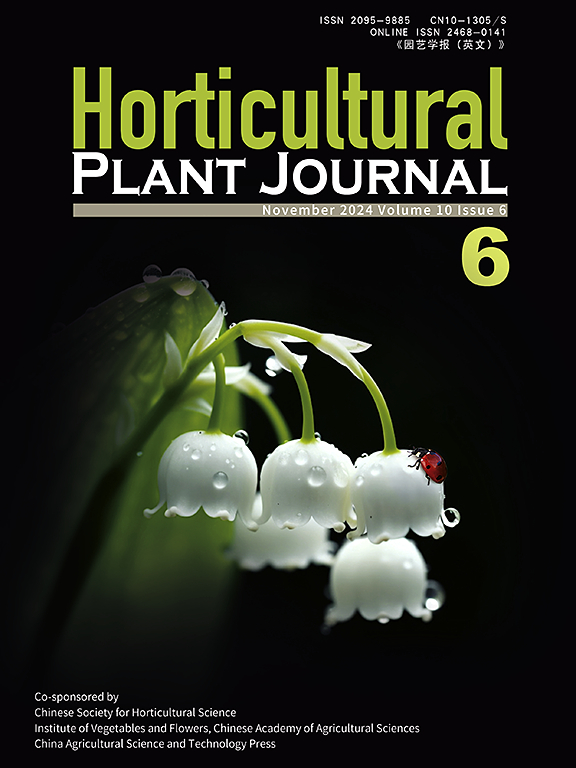QTL mapping of fruit quality traits in tetraploid kiwiberry (Actinidia arguta)
IF 5.7
1区 农林科学
Q1 HORTICULTURE
引用次数: 0
Abstract
Fruit quality traits play an important role in consumption of kiwiberry (). The genetic basis of fruit quality traits in this woody, perennial and dioecious fruit crop remains largely unknown. This study aimed to identify the underlying genetic basis of fruit quality traits in , using a single nucleotide polymorphism (SNP) genetic linkage map previously developed in a tetraploid F population of ‘Ruby-3’ × ‘KuiLv-M’. The F population was phenotyped over three years (2020–2022) for fruit quality traits, including skin color, flesh color, fruit weight, fruit diameter, total soluble solids, fruit longitudinal diameter and fruit shape index. A total of nine QTLs were detected for five traits, explaining 10%–32% of the trait variation. For fruit color, the support interval of a major QTL on LG9 contained an MYB transcription factor MYB110, which was previously demonstrated to control color regulation in kiwifruit, thus suggesting that the is the candidate gene for fruit color in kiwiberry. The linked marker for fruit color was validated in an F population and 25 kiwiberry cultivars. In conclusion, the knowledge obtained through the QTL mapping is applicable to improve the efficiency and cost-effectiveness in kiwiberry breeding.四倍体猕猴桃果实品质性状的 QTL 图谱绘制
果实品质特征对猕猴桃的消费起着重要作用。这种多年生雌雄异株木本水果作物果实品质性状的遗传基础在很大程度上仍然未知。本研究旨在利用之前在'Ruby-3'×'KuiLv-M'的四倍体 F 群体中绘制的单核苷酸多态性(SNP)遗传连锁图,确定猕猴桃果实品质性状的遗传基础。对 F 群体进行了为期三年(2020-2022 年)的果实品质性状表型分析,包括果皮颜色、果肉颜色、果重、果实直径、总可溶性固形物、果实纵径和果形指数。五个性状共检测到 9 个 QTL,解释了 10%-32%的性状变异。在果实着色方面,LG9上一个主要QTL的支持区间包含一个MYB转录因子MYB110,该转录因子之前已被证实控制着猕猴桃的着色调节,因此该转录因子是猕猴桃果实着色的候选基因。在一个 F 群体和 25 个猕猴桃栽培品种中对果实颜色的连锁标记进行了验证。总之,通过 QTL 图谱获得的知识可用于提高猕猴桃育种的效率和成本效益。
本文章由计算机程序翻译,如有差异,请以英文原文为准。
求助全文
约1分钟内获得全文
求助全文
来源期刊

Horticultural Plant Journal
Environmental Science-Ecology
CiteScore
9.60
自引率
14.00%
发文量
293
审稿时长
33 weeks
期刊介绍:
Horticultural Plant Journal (HPJ) is an OPEN ACCESS international journal. HPJ publishes research related to all horticultural plants, including fruits, vegetables, ornamental plants, tea plants, and medicinal plants, etc. The journal covers all aspects of horticultural crop sciences, including germplasm resources, genetics and breeding, tillage and cultivation, physiology and biochemistry, ecology, genomics, biotechnology, plant protection, postharvest processing, etc. Article types include Original research papers, Reviews, and Short communications.
 求助内容:
求助内容: 应助结果提醒方式:
应助结果提醒方式:


